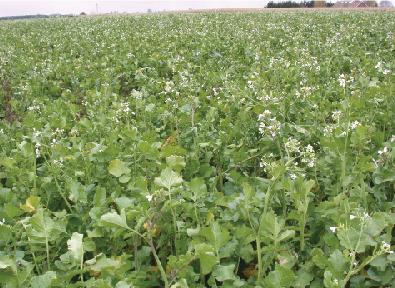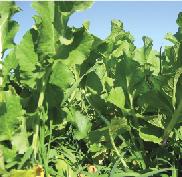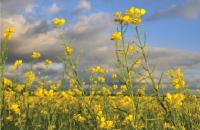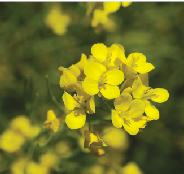
Features
Production
Research
Cover crops can be nature’s fumigants
Many benefits
January 23, 2009 By Hugh McElhone
There are many benefits to cover crops, such as protecting the soil from wind and water erosion during the winter months when it is most vulnerable, suppressing weeds, plus providing organic matter for the next crop while preventing the leaching of nitrates into groundwater.

|
|
|
There are many benefits to cover crops, such as protecting the soil from wind and water erosion during the winter months when it is most vulnerable, suppressing weeds, plus providing organic matter for the next crop while preventing the leaching of nitrates into groundwater. Researchers have found that certain cover crops can also serve as biological fumigants.
While there are many synthetic fumigants on the market, the residue from plants that produce glucosinolates can act as a natural fumigant, says Dr. Mathieu Ngouajio with the department of horticulture, Michigan State University (MSU).
Glucosinolates are secondary plant metabolites produced by 15 different plant families. More than 120 glucosinolates have been identified to date and are most prevalent among the brassica genus of plants, commonly known as the cole crop or mustard family.
 |
|
| Cover crops, such as oilseed radish, can serve as biological fumigants. The long taproot system of the oilseed radish plant makes the crop ideal as a winter cover crop.Photo courtesy of Anne Verhallen, Soil Management Specialist, Horticulture, OMAFRA |
|

|
|
 |
|
| Most brassica crops, such as mustard, require 45 days after sowing to reach the flowering stage, the ideal time to work down the cover crop and incorporate it into the soil. |
Glucosinolates are organic compounds that result when the plant produces one element of glucose and one of sulphur, says Dr. Ngouajio. These substances are responsible for the bitter taste found in Brussels sprouts, horseradish and mustard. They also act as a natural pesticide and deter plant-eating animals.
One glucosinolate of particular interest is called isothiocyanate, the active ingredient in the fumigant Vorlex Plus, which is effective against nematodes and other soil parasites.
As is the case with mustard, the glucosinolates and enzymes produced are not toxic to the plant because it stores them in “separate rooms,” explains Dr. Ngouajio. When the plant is shredded or crushed, the tissue damage allows the compounds to leave their “rooms” and form a liquid chemical that turns into a toxic vapour or “mustard bomb.” It is this action that makes brassicas ideal as a biological fumigant, he says.
While Dr. Ngouajio promotes brassicas in general as a cover crop, he believes some are more ideally suited to certain field crops than others. “You need to select the appropriate species, the seeding rate and the growing time, plus determine your fertilizer needs,” he says, adding the brassica crop chosen must have enough time to grow to the flowering stage but be incorporated before seed heads form.
If the cover crop seed is broadcast, it should be worked into the soil to a depth of one to two inches. A seed drill can also be used if covering a large amount of acres. “We’ve found no difference in either production method. It’s just whatever is easiest for you,” says Dr. Ngouajio.
Some of the optimal seeding rates found by Dr. Ngouajio and his research team include 7 to 10 pounds per acre for the oilseed radish varieties Defender and Diakon. For brown mustard and oriental mustard, six pounds per acre provides adequate biomass, while eight pounds per acre works best for yellow mustard.
“Biomass production varies with the variety and the seeding rate,” he says, adding that if the seeding rate is too high, there is too much competition and less biomass produced. “More is not always better.”
The next step is to crush the tissue at flowering time and incorporate it into the soil. Most brassica crops require 45 days after sowing to reach this stage, which generally works out to June 23.
If the end of June is too late for growers who want their transplants in the ground by mid-May, Dr. Ngouajio suggests they plant oilseed radish. With its large taproot system, the crop can be used as a winter cover crop. While optimal levels are not achieved this way, as the taproot rots, some biofumigants are slowly released into the soil, he
explains.
In their small research plots, the biomass was incorporated with four passes of a rototiller. For larger acreages, a flail-type mower and disc can be used. “The key is to incorporate it immediately, otherwise you’ll lose its value.”
Dr. Ngouajio says his team has found good long-term control results for soil-borne phytophthora and fusarium, with populations kept in check throughout the growing season. This compares well with synthetic fumigants that tend to knock down all organisms in the soil, good and bad alike, with an increase in disease populations generally occurring one month after applying, he says.
In one biofumigant trial, onions were grown following a cover crop of oilseed radish. “Onions need 120 days to grow so both couldn’t be planted in the same year. The oilseed radish was planted the fall before,” he explains.
For onions, the researchers found oilseed radish left the most beneficial organisms in the soil, which led to a significant increase in onion production with one small problem: “We had more bulbs but they were smaller than the control plot which had fewer bulbs but they were bigger,” Dr. Ngouajio says.
He concludes the oilseed radish did too good a job and, with nearly all the onions surviving, there was too much competition, which led to smaller bulbs. To test this theory, the trial was repeated four times on 60 research plots using different seeding rates for oilseed radish.
From these trials, Dr. Ngouajio found the optimal seeding rate to be 172,000 seeds per acre, down from the industry standard of 225,000. At this rate, they achieved a 15.4 per cent increase in onion yield while decreasing seed costs by 24 per cent. The latter is significant, he explains, because oilseed radish seed can be difficult to find and expensive to buy.
As mentioned earlier, not all brassica crops work equally well with all field crops, as Dr. Ngouajio discovered with oilseed radish and celery. From their trials, researchers found that celery fared much better following a cover crop of oriental mustard. “Some 60 per cent of Michigan (celery) growers now use this in their rotation,” he notes.
Among their other findings, Dr. Ngouajio’s team found nematodes were best controlled by oilseed radish compared to oriental mustard, yellow mustard or rapeseed.
His team also found that melon crops, in particular muskmelon, are sensitive to mulched brassica crops and it is best to wait two weeks after soil incorporation before planting.
This research is ongoing and continues to find natural ways to improve vegetable production and reduce costs. “I really like working with the growers and I’m happy if we can earn them one more cent,” says Dr. Ngouajio. ❦
Print this page